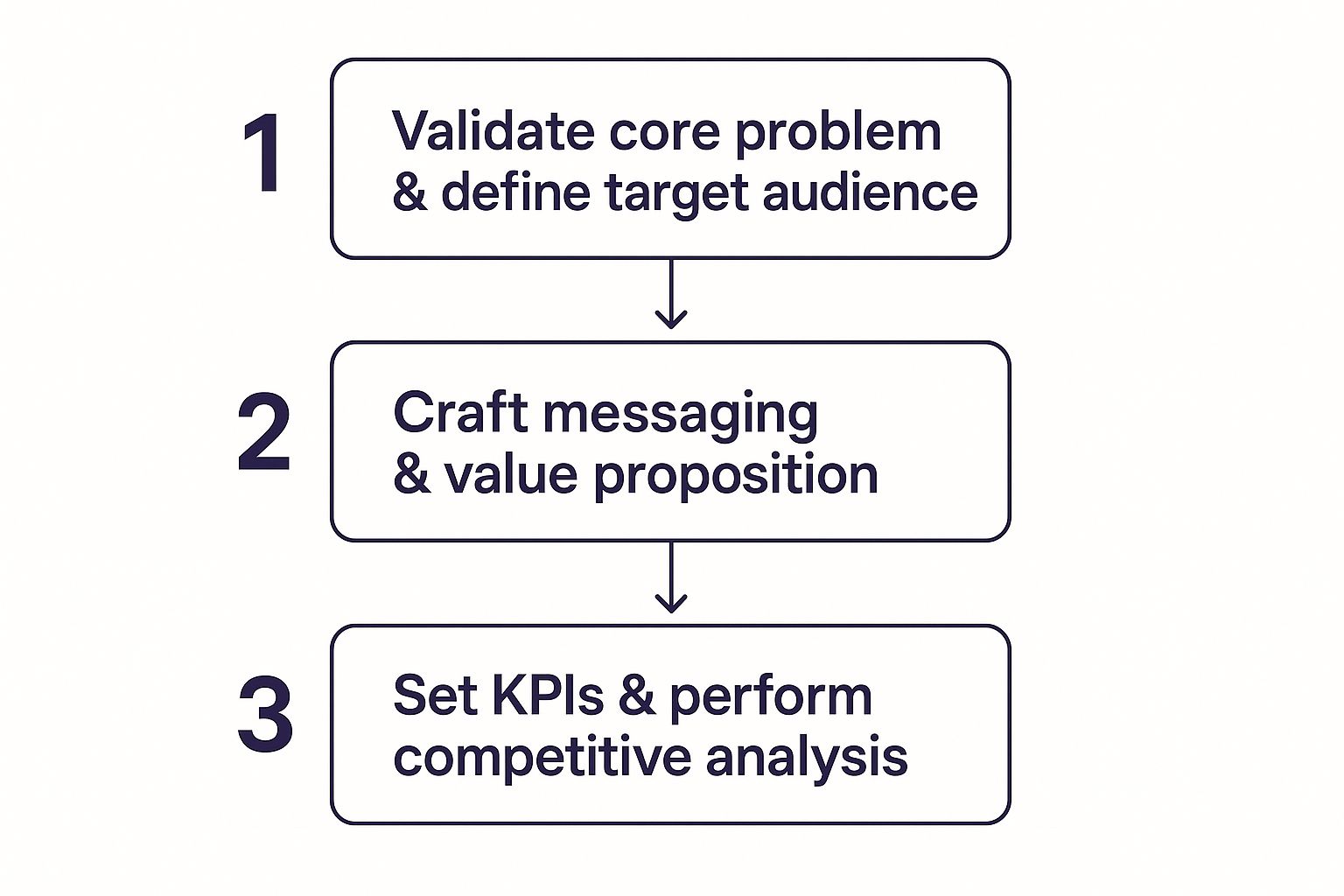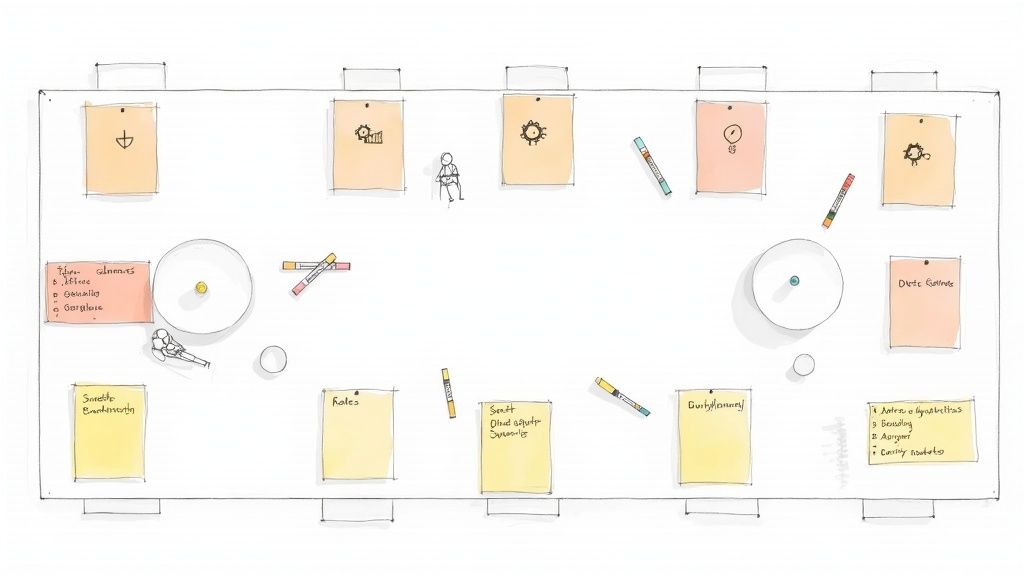Your Essential Product Launch Checklist Template

A solid product launch checklist template is your team's single source of truth. It's what turns launch day chaos into a repeatable, scalable process. Think of it as the framework that maps out every task, from early strategy to post launch analysis, ensuring your marketing, sales, and product teams are perfectly in sync.
That Pre Launch Anxiety You Know Too Well
It's 2 AM. The launch is hours away, and you're wide awake, running through a mental list of everything that could possibly go wrong. Did the final press release get approved? Is the support team actually ready for the flood of tickets? I have been there. My team and I once found a critical payment gateway bug just hours before a major go live. The panic was real.

That feeling is exactly why we ditched scattered documents and fully embraced a centralized system. This is not about creating more bureaucracy; it's about creating clarity. A well designed product launch checklist template is not just a to do list. It's a communication tool, a roadmap, and frankly, an insurance policy against preventable mistakes. It forces the conversations that need to happen and surfaces dependencies long before they become last minute emergencies.
From Chaos To Coordinated Action
Think about the consequences of a misaligned launch. Marketing might be promoting a feature that engineering quietly delayed. The sales team could be caught completely off guard by last minute pricing changes. These are not just minor hiccups; they erode customer trust and absolutely kill team morale.
Successful launches are rarely accidental. Yet, despite how critical preparation is, only about 40% of products launched globally hit their business goals. The cornerstone of a solid plan is market research: companies that truly understand their audience before launch are 2.5 times more likely to achieve high customer satisfaction. You can read more about these product launch findings for the full picture.
Before we go deeper, let's pause and frame the journey. Thinking about the launch in distinct phases will form the backbone of your checklist, ensuring you cover all your bases from start to finish.
The Four Pillars of a Successful Launch
| Launch Phase | Core Objective | Key Teams Involved |
|---|---|---|
| Strategy & Planning | Define goals, target audience, positioning, and success metrics. | Product, Marketing, Leadership |
| Pre Launch Execution | Create all launch assets, prep internal teams, and build market anticipation. | Marketing, Sales, Product, Engineering, Support |
| Launch Day | "Go live" with the product, execute the communication plan, and monitor initial feedback. | All Hands on Deck |
| Post Launch Analysis | Track KPIs against goals, gather customer feedback, and plan for optimization. | Product, Marketing, Sales, Data/Analytics |
This structure ensures that every action is tied back to a clear objective, involving the right people at the right time. A checklist turns your go to market strategy from a high level concept into a series of concrete, actionable steps. It's the bridge between the whiteboard and the real world. This guide will walk you through building that very system. We're going to move from that familiar anxiety to a repeatable framework that gets everyone aligned and ready for launch day.
Laying the Groundwork for a Winning Launch
A successful launch is built long before the public hears a whisper. I've seen too many teams get swept up in the excitement, jumping straight to marketing tactics without a solid strategic foundation. This is where we build that groundwork, ensuring your big day lands with an impact, not a thud.
It all starts with validating the core problem you're solving. I remember one launch where our internal messaging was clever and everyone on the team loved it. The problem? It completely missed the mark with actual customers. That close call taught me to pressure test every single assumption before writing a single line of marketing copy.
Define Your Audience and Value Proposition
Before you can sell anything, you have to know exactly who you're selling to and what unique value you offer them. This is not about broad demographics; it's about getting laser focused.
Who is your ideal customer? What keeps them up at night? What does their day to day workflow look like? Answering these questions helps you move from just another product to an indispensable solution they can't imagine living without.
Once you truly understand your audience, crafting a killer value proposition becomes much clearer. It's that concise, powerful statement that explains:
- What problem you solve: The core pain point your product addresses.
- Who you solve it for: Your specific target audience.
- Why you're different: Your unique edge over the competition.
This simple process flow visualizes how these foundational steps build on each other.

This sequence ensures every action you take later—from setting KPIs to writing ad copy—is rooted in a deep understanding of your market and your unique place within it.
Setting Metrics and Understanding the Landscape
With your audience and messaging locked in, the next move is to define what success actually looks like. Vague goals like "increase awareness" are totally useless. You need meaningful, measurable success metrics—Key Performance Indicators (KPIs)—tied directly to your business objectives. A launch without clear KPIs is like a road trip without a map. You're moving, but you have no idea if you're getting closer to your destination.
Your KPIs will depend on your product and goals, but some solid examples include:
- User Activation Rate: The percentage of new signups who complete a key action.
- Lead to Close Velocity: How quickly a new lead becomes a paying customer.
- Trial Conversion Rate: The percentage of free trial users who upgrade to a paid plan.
At the same time, you have to perform a thorough competitive analysis. This is not just about making a list of features. It's about understanding their market position, their messaging, and their pricing strategy to find your strategic advantage.
This foundational work is critical. In fact, there are many important things to know before starting a startup that can prevent costly mistakes down the line. To make sure all the critical steps are covered so the launch runs smoothly, it's invaluable to consult a comprehensive resource like this checklist for launching B2B products.
Taking these early steps seriously gets everyone on the team rowing in the same direction, transforming a hopeful idea into a well executed plan.
Building Your Go To Market Engine
Once you've nailed down your strategy, it's time to build the machine that actually gets your product out the door. This is the real heart of your product launch checklist template—where we shift from big ideas to the nitty gritty of coordinating marketing, sales, and support. This is not just a to do list; it's your operational playbook.
I'll never forget one launch where two different people thought the other was handling the big announcement email. We caught it with about an hour to spare, but it nearly torpedoed the whole day. It was a painful, unforgettable lesson in why clear ownership is non negotiable. That near miss taught me that assumptions are the enemy of a smooth launch. Every single task, no matter how small, needs a designated owner and a hard deadline. Period.
From Strategy To Actionable Assets
Your go to market engine runs on high quality content and enablement materials. This is where you translate your carefully crafted messaging into tangible assets your teams will use every single day. The goal here is consistency. A prospect should get the same core story whether they're reading a blog post or talking to a sales rep.
This means building out a content calendar that tells a cohesive story over time, not just a one off blast on launch day. Key pieces you'll need include:
- Sales Battle Cards: These are the cheat sheets for your sales team. Quick reference guides packed with key messaging, competitive intel, and answers to tricky questions.
- Demo Scripts: A structured narrative for product demos is crucial. It ensures everyone highlights the core value proposition and consistently solves customer pain points.
- Customer Support FAQs: Get ahead of the curve. Answering the questions you know new users will ask empowers your support team to be genuine product experts from day one.
These assets are the lifeblood of your launch. A great way to frame these early deliverables is by thinking about what's essential for an initial product version. You can get more insights on our guide to startup MVP development services and see how that thinking applies here.

The Technical and Operational Backbone
Beyond the content, you have a whole host of critical operational details to lock down. Think of this as setting up the plumbing that will capture leads, nurture them, and provide a seamless customer experience.
Finalizing your landing pages, setting up marketing automation workflows, and triple checking that your analytics are tracking correctly are all foundational. It's the less glamorous side of a launch, for sure, but getting it right prevents massive headaches down the road.
The move to digital has massively accelerated how teams manage this. In fact, 82% of Fortune 500 companies now use some form of standardized digital checklist or project management platform. It's not just about organization; these tools often include features that cut the average time to launch by 18% compared to traditional methods. If you want to dig deeper, there are some great insights about product launch checklists on Smartsheet.com.
A detailed checklist doesn't just prevent mistakes; it creates a shared reality for the entire team. When everyone knows who is doing what by when, you replace anxiety with alignment and momentum. By covering these critical details and assigning crystal clear ownership, you sidestep those preventable mistakes and build a go to market machine that's ready for anything.
Navigating the Final Launch Week Countdown
Launch week is where all your careful preparation finally collides with reality. This is it. The detailed planning from your product launch checklist template shifts from looking ahead to executing flawlessly and reacting fast. This is where the rubber hits the road, and a calm, methodical approach is everything.
I still get a knot in my stomach thinking about a crisis I handled years ago. We found a critical payment gateway bug just hours before a major go live. Panic started creeping in, but our pre defined 'Go/No Go' meeting framework saved us from what would have been a public relations disaster. It gave us the structure to make a tough but correct call without letting emotion take over.
That experience taught me the final countdown is not about chaos; it's about control. The goal is to make launch day feel like the calm end of a well planned journey, not a desperate firefight.

Mission Critical Final Checks
Before you even think about hitting the big red "launch" button, there are a few non negotiables every team must nail down. These are not just boxes to tick; they are your last line of defense against problems you could have easily prevented.
- Final User Acceptance Testing (UAT): This is one last full run through of the core user journeys by people outside the immediate product team. They bring fresh eyes and are way more likely to catch an awkward workflow or confusing UI that your team has become blind to after staring at it for months.
- Technical Readiness Check: Your engineering lead needs to confirm that all monitoring, alerts, and rollback plans are locked and loaded. What happens if a server crashes? How fast can you revert the deployment if a show stopping bug is found? Not having these answers is just asking for trouble.
- Support Team Briefing: Your support crew needs to be the most prepared team in the building. They should have the final FAQs, workarounds for any known minor issues, and a crystal clear escalation path for bugs they can't solve on their own.
As you head into these last few days, having a detailed product launch countdown strategy can be a huge help for building excitement and making sure all those last minute tasks are handled.
The Decisive Go/No Go Meeting
This is arguably the single most important meeting of the entire launch cycle. It's a formal checkpoint where key stakeholders from every department give their final sign off. The purpose of the Go/No Go meeting isn't to hope for a 'Go'. It's to create a safe space to declare a 'No Go' if critical readiness criteria are not met.
The structure is pretty simple. Each team lead—Engineering, Marketing, Sales, Support—presents their status against a predefined checklist. Is the product stable? Are the marketing campaigns scheduled and ready? Is the sales team trained and equipped? Any single "No" on a mission critical item should trigger a serious discussion about delaying the launch.
This process is a vital part of creating a realistic software project estimate and actually sticking to it. With these final checks in place, you transform launch week from a period of high anxiety into a controlled and confident execution of your plan.
The Real Work Begins After You Launch
Hitting the 'launch' button is not the finish line—it's the starting pistol. Any experienced product team will tell you the first 30 days are what really make or break your momentum. This is where you capture raw, honest feedback, and it's where a solid product launch checklist template proves its long term value by guiding you on what to do next.
I used to think launch day was the peak. But I learned the hard way that the real work—the kind that separates a flash in the pan from a truly successful product—starts the moment the confetti settles. It's about becoming obsessive about what happens in the wild, not just what looked good in your staging environment.
Creating Tight Feedback Loops
Your single most valuable resource right after launch is that first wave of users. They're your pioneers, your early adopters. Their experience, their confusion, and their moments of delight are pure gold. Your main job is to create tight, efficient feedback loops between them and your product team.
This is not about just sitting back and waiting for support tickets to roll in. You have to be proactive and make it ridiculously easy for users to share what's on their mind. Don't wait for users to find you. Go find them. A simple, well timed in app survey or a personal email asking for 15 minutes of their time can uncover insights that analytics alone will never show you.
I can't overstate how powerful this is. One of the best process changes we ever made was scheduling a dedicated 'lessons learned' debrief exactly two weeks after launch, while the experience was still fresh in everyone's mind. That single meeting improved our next launch process by over 30% because it helped us spot patterns in user feedback we would have otherwise completely missed.
Obsess Over The Right Metrics
Data is everywhere, but not all of it matters right after you launch. In those first few weeks, you need to zero in on a handful of key metrics that tell you if you're actually on the right track. This is a critical—and often neglected—part of any good product launch checklist, but its impact is massive.
For instance, companies that systematically track KPIs like sales velocity, customer acquisition cost, and Net Promoter Score (NPS) in the first 90 days see a huge payoff. They tend to improve their next quarter's revenue by an average of 23% compared to those who don't. You can find more great insights on post-launch tracking over at Product School.
Here are the metrics I personally watch like a hawk in the first 30 days:
- User Activation Rate: Are new users completing that crucial first step that makes them "get" the value? This is your single most important leading indicator. If this number is low, nothing else matters.
- Early Churn Rates: Are people signing up and then bailing within a day or a week? This is a huge red flag that signals a major disconnect between your marketing promise and the actual product reality.
- Feature Adoption: Which features are people actually using? And, just as importantly, which ones are they completely ignoring?
This framework—monitoring, reporting, and learning—is what turns every launch into a strategic advantage. It feeds crucial intelligence directly back into your next development cycle, creating a flywheel of continuous improvement.
Key Takeaways
Let's recap what we've journeyed through:
- A product launch checklist template is a communication tool, not just a to do list. It builds clarity and alignment.
- Start with a solid foundation. Define your audience, value proposition, and success metrics before you do anything else.
- Every task needs a clear owner and a deadline. Assumptions are the enemy of a smooth launch.
- The final countdown is about control, not chaos. Use a Go/No Go meeting to make a rational, data driven decision.
- The real work starts after the launch. Create tight feedback loops with your first users and obsess over activation and early retention metrics.
Common Questions About Launch Checklists
As you start piecing together your own product launch checklist template, a few questions inevitably pop up. I've heard them from countless teams over the years, and the answers usually boil down to one thing: being proactive and adaptable. Let's tackle them head on.
When Should We Start Building The Launch Checklist?
The groundwork section should come to life the moment the product scope is locked in. For a standard launch, that's usually 3 to 4 months out. For a major platform release, you might be looking at six months or even longer.
The whole point is to get in early enough that your market research and strategic planning can actually shape the product and how you talk about it. If you wait too long, the checklist just becomes a frantic box checking exercise right before the big day, which completely defeats the purpose.
What Is The Biggest Mistake Teams Make?
The most common trap I see is treating the template as a rigid, unchangeable document. A product launch checklist has to be a living tool. You must adapt it to the specific scale and impact of your launch. A minor feature update, for example, definitely doesn't need a full blown public relations campaign.
Use your template as a comprehensive guide, but be pragmatic. Cut tasks that don't add real value for a smaller release. The checklist is a compass, not a cage. It should guide your decisions and help you adapt, not lock you into a process that no longer makes sense for the situation at hand.
How Do You Get Other Teams To Actually Use It?
You get genuine buy in by making it their tool, not just your chore list. Simple as that.
When you first customize the template for a new launch, pull in leaders from marketing, sales, and support. Ask them point blank what they need for a smooth launch from their end. Build their dependencies and deliverables directly into the plan.
Once they see how the checklist prevents last minute scrambles and clarifies who owns what, they'll become its biggest advocates. Frame it as a tool for transparency and shared success—never as a micromanagement tactic.
Document Or Project Management Tool?
While a document is a heck of a lot better than nothing, a real project management tool like Asana, Jira, or Trello is miles ahead for a dynamic process like a launch.
These tools give you clear ownership, due dates, task dependencies, and—most importantly—real time status updates for everyone to see.
A static document gets outdated almost immediately, leading to confusion about which version is the "latest." Your goal should be a single source of truth, and a dynamic project board is the best way to create one.
I'm Kuldeep Pisda, and I specialize in helping startups navigate these complex processes. If you're looking to build robust, scalable systems and need guidance on everything from technical architecture to launch readiness, I'd be happy to explore how I can help. You can learn more about my full stack consulting at https://kdpisda.in.
Subscribe to our newsletter.
Become a subscriber receive the latest updates in your inbox.






Member discussion